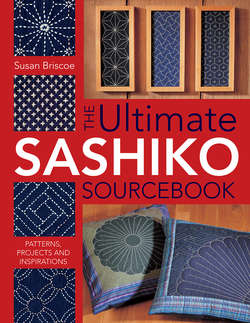Читать книгу The Ultimate Sashiko Sourcebook - Susan Briscoe - Страница 9
На сайте Литреса книга снята с продажи.
Regional sashiko traditions
ОглавлениеSashiko may have evolved independently in various parts of Japan or it may have originated in one area and spread from there. Design similarities between different regions suggest sashiko was spread by trade. It is associated with the Japan Sea coast and the north, where it was used as farmer’s clothing. In the south it was worn by fishermen only. Edo era Shōnai sashiko survives and there are 19th-century examples from many other areas along the Japan Sea trade route.
The map opposite shows the Kitamaebune coastal trading route, which during the Edo era linked the Kansai region (around Kyoto) with the north-western coast of Tohoku via the Inland Sea and the Sea of Japan. Ships travelled the route yearly, leaving Osaka and trading all along the coast, up to Hokkaido. The trade brought cotton to the far north, as raw fibre, thread and fabric (old and new). It played an important role in the distribution of ideas, which must have included sashiko designs.
Shōnai sashiko has a vast range of patterns, mostly hitomezashi. This prosperous agricultural region was a meeting point of Edo, Kamigata and Tohoku cultures and design. Kakurezashi (hidden sashiko), over-dyed with indigo so the pattern is revealed as it fades, and chirimenzashi (crêpe sashiko), where straight stitch lines were deliberately puckered up to resemble crêpe, were also made.
Fishing boats on the Inland Sea, Awaji Island. Stylized wave, mist and net patterns on sashiko clothes reflected the environment and the importance of the sea’s bounty for coastal communities.
EARLY 20TH-CENTURY POSTCARD, AUTHOR’S COLLECTION
Peasant woman weaving checked cotton at home. The takabata (high loom) replaced the ancient izaribata back strap looms in rural homes during the 19th century. Cloth woven on the izaribata is only as wide as the weaver’s body, hence the narrow width of traditional Japanese cloth.
STEREO-VIEW PHOTOGRAPH 1904, AUTHOR’S COLLECTION
Three generations of women hand spinning on the veranda. Note the kagome bamboo baskets in the foreground (see pages 83 and 100 for kagome sashiko patterns).
EARLY 20TH-CENTURY POSTCARD, AUTHOR’S COLLECTION
